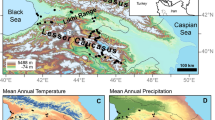Abstract
Phytolith analysis was used to reconstruct two centuries of floral history for the yards of two structures at Harpers Ferry, West Virginia: the first master armorer’s residence and an armory worker’s house. The decay-in-place tendency of phytolith deposition provided insight into both general conditions of floral assemblages and specific floristic patterns in the adjacent lots of the respective residences. Contrasts between prehistoric flora and that resulting from impact of European arrival was evident in the phytolith record. Phytolith analysis also revealed specific aspects of landscaping—or the lack of it—as effected by the sequence of occupants in the houses.
Similar content being viewed by others
References
Bozarth, Stephen R. 1987 Diagnostic Opal Phytoliths from Rinds of Selected Cucurbita Species. American Antiquity 52(3):607–615.
1990 Diagnostic Opal Phytoliths from Pods of Selected Varieties of Common Beans (Phaseolus vulgaris). American Antiquity 55(1):98–104.
1992 Classification of Opal Phytoliths Formed in Selected Dicotyledons Native to the Great Plains. In Phytolith Systematics: Emerging Issues, edited by G. Rapp, Jr., and S. C. Mulholland, pp. 193–214. Plenum Press, New York.
Brown, Dwight A. 1984 Prospects and Limits of a Phytolith Key for Grasses in the Central United States. Journal of Archaeological Science 11(4):345–368.
Cummings, Linda S. 1992 Illustrated Phytoliths from Assorted Food Plants. In Phytolith Systematics: Emerging Issues, edited by G. Rapp, Jr., and S. C. Mulholland, pp. 175–192. Plenum Press, New York.
Fisher, William F. 1987 Part IV: Report on the Analysis of Opal Phytoliths from Excavations at the Kirk Street Agents’ House, Lowell, Massachusetts. In Interdisciplinary Investigations of the Boott Mills, Lowell, Massachusetts. Vol. 2, The Kirk Street Agents’ House, edited by Mary C. Beaudry and Stephen A. Mrozowski. Cultural Resources Management Study 19:122–130. Division of Cultural Resources, National Park Service, North Atlantic Regional Office, Boston, Massachusetts.
Geis, James W. 1973 Biogenic Silica in Selected Species of Deciduous Angiosperms. Soil Science 116(2):113–119.
Klein, Robert L., and James W. Geis 1978 Biogenic Silica in the Pinaceae. Soil Science 126(3): 145–156.
Kondo, Renzo 1974 Opal Phytoliths—The Relations between the Morphological Features of Opal Phytoliths and the Taxonomic Groups of Gramineous Plants. Pedorojisuto (Pedologist) 18:2–10.
1976 On the Opal Phytoliths of Tree Origins. Pedorojisuto (Pedologist) 20:176–190.
1977 Opal Phytoliths, Inorganic, Biogenic Particles in Plants and Soils. Japan Agricultural Research Quarterly 11(4): 198–203.
Kondo, Renzo, and Tomoko Peason 1981 Opal Phytoliths in Tree Leaves (Part 2): Opal Phytoliths in Dicotyledonous Angiosperm Tree Leaves. Research Bulletin of Obihiro University, series 1, 12(3):217–230.
Kondo, Renzo, and Takahashi Sase 1986 Opal Phytoliths, Their Nature and Application. Daiyonki Kenkyu (Quaternary Research) 25(1):31–63.
Kondo, Renzo, Takahashi Sase, and Y. Kato 1987 Opal Phytolith Analysis of Andisols with Regard to Interpretation of Paleovegetation. Proceedings of the Ninth International Soil Classification Workshop, Japan: 520–534. D. I. Kinloch et al., editors. Tokyo.
Kondo, Renzo, and T. Sumida 1978 The Study of Opal Phytoliths of Tree Leaves, I; Opal Phytoliths in Gymnosperm and Monocotyledonous Angiosperm Tree Leaves. Journal of the Science of Soil and Manure, Japan 49(2): 138–144.
Parry, D. Wynn, and Frank Smithson 1958 Silicification of Bulliform Cells in Grasses. Nature 181:1549–1550.
Piperno, Dolores R. 1988 Phytolith Analysis: An Archaeological and Geological Perspective. Academic Press, San Diego, California.
Rovner, Irwin 1971 Potential of Opal Phytoliths for Use in Paleoecological Reconstruction. Quaternary Research (1)3:345–359.
1972 Note on a Safer Procedure for Opal Phytolith Extraction. Quaternary Research (2)4:591.
1983 Major Advances in Archaeobotany: Archaeological Uses of Opal Phytolith Analysis. Advances in Archaeological Method and Theory 6:225–266. Michael B. Schiffer, editor. Academic Press, New York.
1988a Micro- and Macro-environmental Reconstruction Using Plant Opal Phytolith Data from Archaeological Sediments. Geoarchaeology 3(2): 155–165.
1988b Quick-scan Phytolith Analysis of Selected Soil Samples from Suggested Fodder Plots at Monticello, Virginia. Report prepared by Binary Analytical Consultants, Raleigh, North Carolina. Submitted to the Monticello Foundation, Charlottesville, Virginia.
1990a Fine-tuning Floral History with Opal Phytolith Analysis. In Earth Patterns, Essays in Landscape Archaeology, edited by William M. Kelso and Rachel Most, pp. 297–308. University Press of Virginia, Charlottesville.
1990b Analysis of Phytolith Assemblages Extracted from Dental Tartar of 18th- and 19th-century Domestic Herbivores from the City of Hampton, Virginia. Report prepared by Binary Analytical Consultants, Raleigh, North Carolina. Submitted to Archaeology Project Center, College of William and Mary, Williamsburg, Virginia.
Shackel, Paul, and Ellen A. Armbruster 1990 Landscape Report: Archeological Component, Package 116: Block B, Lots 2 & 3, Buildings 32, 33, 33A, 34, 34A, 35, & 36 Shenandoah Street, Harpers Ferry National Historic Park, Harpers Ferry, West Virginia. Draft report on file, Archeology Division, Harpers Ferry National Historical Park, Harpers Ferry, West Virginia.
Twiss, Page C., Erwin Suess, and Robert M. Smith 1969 Morphological Classification of Grass Phytoliths. Soil Science Society of America Proceedings 33(1): 109–115.
Author information
Authors and Affiliations
Rights and permissions
About this article
Cite this article
Rovner, I. Floral history by the back door: A test of phytolith analysis in residential yards at Harpers Ferry. Hist Arch 28, 37–48 (1994). https://doi.org/10.1007/BF03374199
Published:
Issue Date:
DOI: https://doi.org/10.1007/BF03374199




